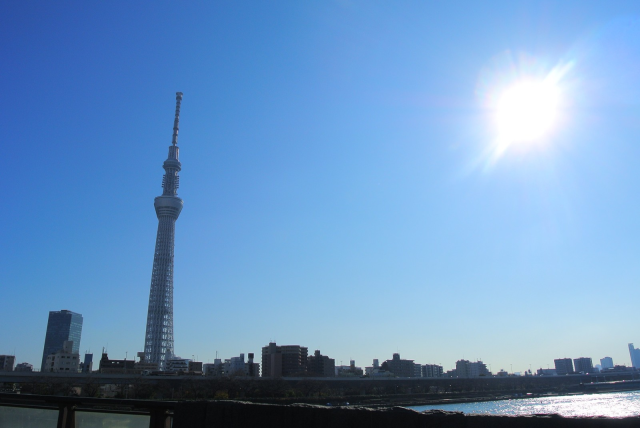
Atomic clock confirms that Tokyo’s tallest tower is also its most futuristic.
As the tallest structure in Japan, the Tokyo Skytree provides unparalleled views of the city and its surroundings and the exhilaration of standing farther off the ground than anyone in the country who’s not in an airplane. But it turns out there’s something else you can add to what the Skytree offers: time acceleration.
In simplified terms, Einstein’s general theory of relativity holds that time moves more slowly where gravity is heavier, and faster where there’s less gravity. Under that logic, University of Tokyo quantum electronics professor Hidetoshi Katori wanted to see what’s happening with the flow of time at the Skytree’s 450-meter (1,476-foot)-high observation floor. Using an optical lattice clock (a kind of atomic clock accurate up to a one-second differential over 30 billion years), Katori and his research team took measurements and determined that time is indeed moving faster up in the observatory than it is at Tokyo street level.
For each second that passes on the surface, the researchers found that an extra five trillionths of a second have elapsed on the Skytree’s observation floor. Stretched out over the course of an entire day, that works out to an extra four billionths of a second.
Unfortunately, that time acceleration isn’t significant enough for us to take a quick ride in the Skytree’s elevator in order to get a head start on the weekend. However, Katori says he believes there can be practical applications of this knowledge, and considering that the very tip of the Skytree is 634 meters above the ground, it stands to reason that time is passing even more quickly there.
Sources: Kyodo via Hachima Kiko, Mainichi Shimbun, Nature Photonics
Top image: Pakutaso
● Want to hear about SoraNews24’s latest articles as soon as they’re published? Follow us on Facebook and Twitter!

 Tokyo Skytree to install VR viewer for rainy days
Tokyo Skytree to install VR viewer for rainy days No, the Tokyo Skytree wasn’t lit in colors of Ukraine for solidarity…but another landmark is
No, the Tokyo Skytree wasn’t lit in colors of Ukraine for solidarity…but another landmark is Evangelion taking over Tokyo Skytree just in time for Christmas
Evangelion taking over Tokyo Skytree just in time for Christmas Sakura Skytree photos take Tokyo’s breath away, give kick-start to cherry blossom season【Photos】
Sakura Skytree photos take Tokyo’s breath away, give kick-start to cherry blossom season【Photos】 Tokyo Skytree to light up in Demon Slayer character colors as part of tie-up event with anime hit
Tokyo Skytree to light up in Demon Slayer character colors as part of tie-up event with anime hit Foreigner’s request for help in Tokyo makes us sad for the state of society
Foreigner’s request for help in Tokyo makes us sad for the state of society Japanese-style accommodation at the new Premium Dormy Inn hotel in Asakusa will blow your mind
Japanese-style accommodation at the new Premium Dormy Inn hotel in Asakusa will blow your mind Seaside scenery, history, and so many desserts on Yokohama’s Akai Kutsu【Japan Loop Buses】
Seaside scenery, history, and so many desserts on Yokohama’s Akai Kutsu【Japan Loop Buses】 Japanese city loses residents’ personal data, which was on paper being transported on a windy day
Japanese city loses residents’ personal data, which was on paper being transported on a windy day Mikado Coffee is a 76-year-old coffee chain with a major celebrity connection
Mikado Coffee is a 76-year-old coffee chain with a major celebrity connection Japanese ramen restaurants under pressure from new yen banknotes
Japanese ramen restaurants under pressure from new yen banknotes Japan’s summertime towelket pillowcases are even better with the addition of Ghibli stars【Photos】
Japan’s summertime towelket pillowcases are even better with the addition of Ghibli stars【Photos】 Suntory x Super Mario collaboration creates a clever way to transform into Mario【Videos】
Suntory x Super Mario collaboration creates a clever way to transform into Mario【Videos】 A visit to the best UFO catcher arcade in the universe!
A visit to the best UFO catcher arcade in the universe! The results are in! One Piece World Top 100 characters chosen in global poll
The results are in! One Piece World Top 100 characters chosen in global poll McDonald’s new Happy Meals offer up cute and practical Sanrio lifestyle goods
McDonald’s new Happy Meals offer up cute and practical Sanrio lifestyle goods French Fries Bread in Tokyo’s Shibuya becomes a hit on social media
French Fries Bread in Tokyo’s Shibuya becomes a hit on social media Red light district sushi restaurant in Tokyo shows us just how wrong we were about it
Red light district sushi restaurant in Tokyo shows us just how wrong we were about it New private rooms on Tokaido Shinkansen change the way we travel from Tokyo to Kyoto
New private rooms on Tokaido Shinkansen change the way we travel from Tokyo to Kyoto Tokyo Tsukiji fish market site to be redeveloped with 50,000-seat stadium, hotel, shopping center
Tokyo Tsukiji fish market site to be redeveloped with 50,000-seat stadium, hotel, shopping center Beautiful Ghibli sealing wax kits let you create accessories and elegant letter decorations【Pics】
Beautiful Ghibli sealing wax kits let you create accessories and elegant letter decorations【Pics】 Secret Kitchen bento serves Japanese flowers, birds, wind and moon in a box, but is it worth it?
Secret Kitchen bento serves Japanese flowers, birds, wind and moon in a box, but is it worth it? New definition of “Japanese whiskey” goes into effect to prevent fakes from fooling overseas buyers
New definition of “Japanese whiskey” goes into effect to prevent fakes from fooling overseas buyers Our Japanese reporter visits Costco in the U.S., finds super American and very Japanese things
Our Japanese reporter visits Costco in the U.S., finds super American and very Japanese things Studio Ghibli releases Kiki’s Delivery Service chocolate cake pouches in Japan
Studio Ghibli releases Kiki’s Delivery Service chocolate cake pouches in Japan All-you-can-drink Starbucks and amazing views part of Tokyo’s new 170 meter-high sky lounge
All-you-can-drink Starbucks and amazing views part of Tokyo’s new 170 meter-high sky lounge More foreign tourists than ever before in history visited Japan last month
More foreign tourists than ever before in history visited Japan last month New Pokémon cakes let you eat your way through Pikachu and all the Eevee evolutions
New Pokémon cakes let you eat your way through Pikachu and all the Eevee evolutions Disney princesses get official manga makeovers for Manga Princess Cafe opening in Tokyo
Disney princesses get official manga makeovers for Manga Princess Cafe opening in Tokyo Sales of Japan’s most convenient train ticket/shopping payment cards suspended indefinitely
Sales of Japan’s most convenient train ticket/shopping payment cards suspended indefinitely Sold-out Studio Ghibli desktop humidifiers are back so Totoro can help you through the dry season
Sold-out Studio Ghibli desktop humidifiers are back so Totoro can help you through the dry season Japanese government to make first change to romanization spelling rules since the 1950s
Japanese government to make first change to romanization spelling rules since the 1950s Ghibli founders Toshio Suzuki and Hayao Miyazaki contribute to Japanese whisky Totoro label design
Ghibli founders Toshio Suzuki and Hayao Miyazaki contribute to Japanese whisky Totoro label design Doraemon found buried at sea as scene from 1993 anime becomes real life【Photos】
Doraemon found buried at sea as scene from 1993 anime becomes real life【Photos】 Tokyo’s most famous Starbucks is closed
Tokyo’s most famous Starbucks is closed One Piece characters’ nationalities revealed, but fans have mixed opinions
One Piece characters’ nationalities revealed, but fans have mixed opinions We asked a Uniqlo employee what four things we should buy and their suggestions didn’t disappoint
We asked a Uniqlo employee what four things we should buy and their suggestions didn’t disappoint Japanese astrophysicists assure us that we have a long time before our universe rips apart
Japanese astrophysicists assure us that we have a long time before our universe rips apart Is this Tokyo, or Final Fantasy? Rainy season night makes for incredible Skytree view【Photos】
Is this Tokyo, or Final Fantasy? Rainy season night makes for incredible Skytree view【Photos】 Lightning storm photos of the Skytree show the Tokyo symbol in a whole new light【Photos】
Lightning storm photos of the Skytree show the Tokyo symbol in a whole new light【Photos】 Japan has a random hotel room gacha capsule vending machine
Japan has a random hotel room gacha capsule vending machine Tokyo Skytree gets some extra decoration thanks to the Blood Moon Eclipse【Photos】
Tokyo Skytree gets some extra decoration thanks to the Blood Moon Eclipse【Photos】 New virtual reality attraction allows thrill-seekers to bungee jump off Tokyo Tower
New virtual reality attraction allows thrill-seekers to bungee jump off Tokyo Tower The top 10 Instagram photo locations for Japan in 2014 【Photos】
The top 10 Instagram photo locations for Japan in 2014 【Photos】 Japanese candy artisan opens new store below Tokyo Skytree with exclusive sweets
Japanese candy artisan opens new store below Tokyo Skytree with exclusive sweets Japan’s craziest shaved ice is so huge you can’t eat it sitting down
Japan’s craziest shaved ice is so huge you can’t eat it sitting down Tokyo Tower celebrates Tanabata with a beautiful case of the summertime blues
Tokyo Tower celebrates Tanabata with a beautiful case of the summertime blues Mr. Sato attacks a massive castle of seafood at a new restaurant in Tokyo Skytree’s Solamachi
Mr. Sato attacks a massive castle of seafood at a new restaurant in Tokyo Skytree’s Solamachi Awesome optical illusion turns Japanese Ferris wheel into a cube 【Video】
Awesome optical illusion turns Japanese Ferris wheel into a cube 【Video】 In Japan and the rest of the world, 2017 comes with a bit of extra time thanks to the leap second
In Japan and the rest of the world, 2017 comes with a bit of extra time thanks to the leap second Tokyo Skytree to light up as three traditional Japanese meals in honour of “Washoku Day”
Tokyo Skytree to light up as three traditional Japanese meals in honour of “Washoku Day” Tokyo experiences drop in population for seventh consecutive month
Tokyo experiences drop in population for seventh consecutive month
Leave a Reply